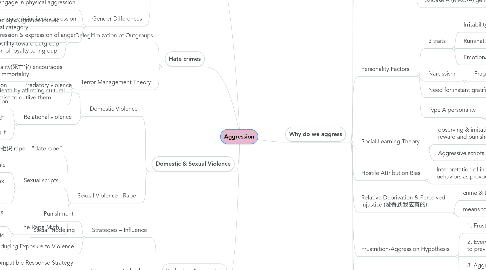
1. What is aggresion
1.1. Types of Aggression
1.1.1. Physical aggression
1.1.2. Hostile aggression
1.1.2.1. to cause injury or death
1.1.2.2. “Expressive” aggression
1.1.3. Instrumental aggression
1.1.3.1. to achieve some other goal
1.1.4. Social aggression
1.1.4.1. harm another’s emotional and social wellbeing without causing physical injury
1.2. Provocation
1.2.1. Action or speech meant to elicit negative affect
1.2.2. Effects increased when there is an audience: element of losing face
1.3. Gender Differences
1.3.1. Men more likely to engage in physical aggression
1.3.2. Women more likely to engage in indirect aggression
1.3.3. No difference on verbal aggression & expression of anger
2. Hate crimes
2.1. Delegitimization of Outgroups
2.1.1. Cognitive process of placing outgroups into an extremely negative social category
2.1.2. Increased hostility toward outgroup Intensification of loyalty to ingroup
2.2. Terror Management Theory
2.2.1. Awareness of own mortality(死亡率) encourages us to symbolically seek immortality
2.2.2. Respond to fear of death by affirming cultural worldviews that promise to outlive them
3. Domestic & Sexual Violence
3.1. Domestic Violence
3.1.1. Predatory violence
3.1.1.1. Primary motivation is sexual exploitation
3.1.2. Relational violence
3.1.2.1. Motivated by jealousy & perceived rejection
3.1.2.2. Precariousness不稳定 of “manhood” e.g. Man as provider; losing face Aggression as a means of restoring it
3.2. Sexual Violence - Rape
3.2.1. Acquaintance相识 rape – “date rape”
3.2.2. Sexual scripts
3.2.2.1. Predator male
3.2.2.2. Resistant female – token resistance to sex (refusing when they actually intend to engage in sex)
3.2.3. The Rape Myth
3.2.3.1. False belief that women find forced sex enjoyable & sexually stimulating
3.2.3.2. Perpetuated by sexual violence in pornographic movies
4. Reducing Aggression
4.1. Strategies – Influence
4.1.1. Punishment
4.1.2. Social Modeling
4.1.3. Reducing Exposure to Violence
4.2. Strategies – Individual
4.2.1. Incompatible Response Strategy
4.2.1.1. Making an angry person laugh
4.2.2. Apologies
4.3. Strategies - Training
4.3.1. Social Skills
4.3.2. Self-Affirmation
4.3.3. Internalization of Anti-Aggression Beliefs
4.3.3.1. Form of self-generated persuasion
5. Why do we aggress
5.1. Evolutionary Factors
5.1.1. reproductive success
5.1.2. Genetic survival -Less likely to aggress against blood relatives
5.2. Biological Factors
5.2.1. Serotonin
5.2.1.1. Neurotransmitter regulating sleep, appetite & mood
5.2.1.2. Lower levels linked to increased aggression
5.2.2. Testosterone
5.2.2.1. Higher levels linked to increased aggression in both sexes
5.2.2.2. Bidirectionality: Winning competitions increases testosterone levels
5.2.3. Mutations in the monoamine oxidase A (MAO-A) gene
5.2.3.1. “Off switch” for neurotransmitters such as serotonin
5.2.3.2. “warrior gene”
5.3. Personality Factors
5.3.1. 3 traits
5.3.1.1. Irritability
5.3.1.2. Rumination
5.3.1.2.1. Tendency to retain feelings of anger
5.3.1.3. Emotional susceptibility 敏感度
5.3.2. Narcissism
5.3.2.1. Fragile self-esteem: high explicit SE but low implicit SE
5.3.3. Need for instant gratification
5.3.4. Type A personality
5.3.4.1. competitiveness, time urgency (impatience), and hostility
5.4. Social Learning Theory
5.4.1. observing & imitating others, and being directly reward and punished for our own actions
5.4.2. Aggressive scripts
5.5. Hostile Attribution Bias
5.5.1. Interpretation of innocent or ambiguous behaviors as provocation (自己太敏感)
5.6. Relative Deprivation & Perceived Injustice (没得到我应有的)
5.6.1. crime & terrorism
5.6.2. means to punish others for perceived injustices
5.7. Frustration-Aggression Hypothesis
5.7.1. 1. Frustration elicits need to aggress
5.7.2. 2. Every act of aggression can be traced to previous frustration
5.7.3. 3. Aggression causes catharsis (relieving) -Not always
5.8. Heat Hypothesis
5.8.1. Hot temperatures increase hostile thoughts & feelings
5.9. Media Influence
5.10. Aggressive Cues
5.10.1. Aggression-associated cues can heighten aggression ex:gun
